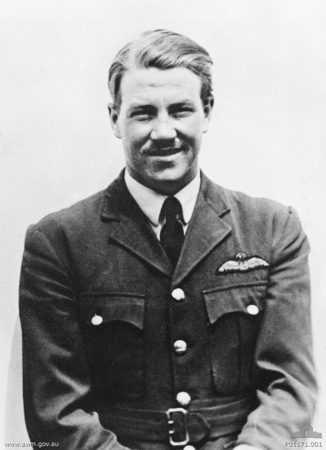Hughes, Paterson Clarence
- Date of birth:
- September 19th, 1917 (Numeralla/New South Wales, Australia)
- Date of death:
- September 7th, 1940 (Sundridge/Kent, Great Britain)
- Buried on:
- Commonwealth War Graves St James Churchyard
Row: G. Grave: 4. - Service number:
- 39461
- Nationality:
- Australian
Biography
Paterson Hughes joined the RAAF in January 1936 but sailed twelve months later for England where he joined the RAF where he was posted to No. 64 Squadron (Fighter Command).
In November 1939 he was posted to No. 234 Squadron. After a break to marry, he rapidly gained several victories. On 15 August Hughes shot down a Messerschmitt Bf 110 and shared in the dispatch of a second. He was successful on the 16th, 18th and 26th, each time destroying two Messerschmitt Bf 109s. An advocate of closing in for a certain 'kill', he accounted for three Bf 110s on 4 September, two Bf 109s on the 5th and at least one Bf 109 on the 6th. One of his victims on 5 September may have been Oberleutnant Franz von Werra, the flamboyant German ace who later became known as "The One That Got Away". Between 13 August and 7 September the squadron shot down 63 enemy aircraft and fought to the point of exhaustion. Hughes contributed at least 14 confirmed, 1 probable and 3 shared.
Hughes was killed on the 7th of September 1940 whilst attacking a Dornier at point blank range. The Dornier blew up and his Spitfire was hit by the part of the wing and it crashed in Kent at 18:30hrs. Hugh's body, thrown clear of his aircraft, came down into a garden in the nearby village of Sundridge.
Promotions:
19 February, 1937: Pilot Officer
19 November, 1938: Flying Officer
3 September, 1940: Flight Lieutenant
Do you have more information about this person? Inform us!
- Period:
- Second World War (1939-1945)
- Rank:
- Acting Flight Lieutenant
- Awarded on:
- October 22nd, 1940
"This officer has led his flight with skill and determination. He has displayed gallantry in his attacks on the enemy and has destroyed seven aircraft."
- Period:
- Second World War (1939-1945)
- Period:
- Second World War (1939-1945)
Sources
- Photo 1:
- Photo: Australian Dictionary of Biography
- Wikipedia - - The London Gazette Issue 34376 published on the 2 March 1937
- The London Gazette Issue 34577 published on the 6 December 1938
- The London Gazette Issue 34954 published on the 27 September 1940
- The London Gazette Issue 34976 published on the 22 October 1940
- Australian Dictionary of Biography
- Australian War Memorial
- Val & Rob Haywood
- The Battle of Britain
- Commonwealth War Graves Commission






